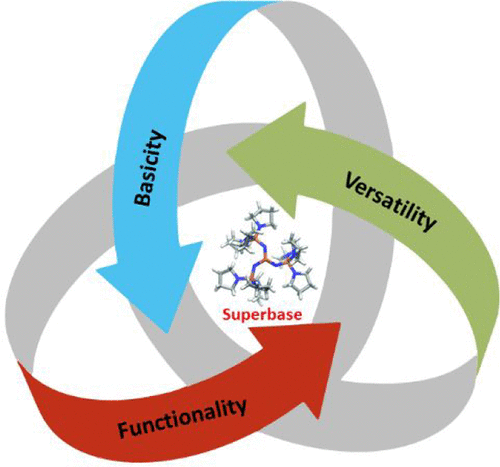当前位置:
X-MOL 学术
›
Acc. Chem. Res.
›
论文详情
Our official English website, www.x-mol.net, welcomes your feedback! (Note: you will need to create a separate account there.)
Design of Novel Uncharged Organic Superbases: Merging Basicity and Functionality
Accounts of Chemical Research ( IF 18.3 ) Pub Date : 2021-07-26 , DOI: 10.1021/acs.accounts.1c00297 Katarina Vazdar 1 , Davor Margetić , Borislav Kovačević , Jörg Sundermeyer 2 , Ivo Leito 3 , Ullrich Jahn 1
Accounts of Chemical Research ( IF 18.3 ) Pub Date : 2021-07-26 , DOI: 10.1021/acs.accounts.1c00297 Katarina Vazdar 1 , Davor Margetić , Borislav Kovačević , Jörg Sundermeyer 2 , Ivo Leito 3 , Ullrich Jahn 1
Affiliation

|
One of the constant challenges of synthetic chemistry is the molecular design and synthesis of nonionic, metal-free superbases as chemically stable neutral organic compounds of moderate molecular weight, intrinsically high thermodynamic basicity, adaptable kinetic basicity, and weak or tunable nucleophilicity at their nitrogen, phosphorus, or carbon basicity centers. Such superbases can catalyze numerous reactions, ranging from C–C bond formation to cycloadditions and polymerization, to name just a few. Additional benefits of organic superbases, as opposed to their inorganic counterparts, are their solubility in organic reaction media, mild reaction conditions, and higher selectivity. Approaching such superbasic compounds remains a continuous challenge. However, recent advances in synthetic methodology and theoretical understanding have resulted in new design principles and synthetic strategies toward superbases. Our computational contributions have demonstrated that the gas-phase basicity region of 350 kcal mol–1 and even beyond is easily reachable by organosuperbases. However, despite record-high basicities, the physical limitations of many of these compounds become quickly evident. The typically large molecular weight of these molecules and their sensitivity to ordinary reaction conditions prevent them from being practical, even though their preparation is often not too difficult. Thus, obviously structural limitations with respect to molecular weight and structural complexity must be imposed on the design of new synthetically useful organic superbases, but strategies for increasing their basicity remain important.
中文翻译:

新型不带电有机超碱的设计:结合碱性和功能
合成化学的持续挑战之一是非离子、无金属超碱的分子设计和合成,这些超碱是化学稳定的中性有机化合物,具有中等分子量、固有的高热力学碱性、适应性强的动力学碱性和弱或可调节的氮亲核性,磷或碳碱度中心。这种超碱可以催化许多反应,从 C-C 键的形成到环加成和聚合,仅举几例。与无机超强碱相比,有机超强碱的其他优点是它们在有机反应介质中的溶解性、温和的反应条件和更高的选择性。接近这种超碱性化合物仍然是一个持续的挑战。然而,合成方法学和理论理解的最新进展导致了针对超碱的新设计原则和合成策略。我们的计算贡献表明,350 kcal mol 的气相碱度区域–1甚至更高可以通过有机超碱轻松达到。然而,尽管碱度创历史新高,但许多这些化合物的物理局限性很快变得明显。这些分子的典型大分子量和它们对普通反应条件的敏感性使它们无法实用,即使它们的制备通常不太困难。因此,在设计新的合成有用的有机超强碱时,必须对分子量和结构复杂性施加明显的结构限制,但增加其碱度的策略仍然很重要。
更新日期:2021-08-03
中文翻译:

新型不带电有机超碱的设计:结合碱性和功能
合成化学的持续挑战之一是非离子、无金属超碱的分子设计和合成,这些超碱是化学稳定的中性有机化合物,具有中等分子量、固有的高热力学碱性、适应性强的动力学碱性和弱或可调节的氮亲核性,磷或碳碱度中心。这种超碱可以催化许多反应,从 C-C 键的形成到环加成和聚合,仅举几例。与无机超强碱相比,有机超强碱的其他优点是它们在有机反应介质中的溶解性、温和的反应条件和更高的选择性。接近这种超碱性化合物仍然是一个持续的挑战。然而,合成方法学和理论理解的最新进展导致了针对超碱的新设计原则和合成策略。我们的计算贡献表明,350 kcal mol 的气相碱度区域–1甚至更高可以通过有机超碱轻松达到。然而,尽管碱度创历史新高,但许多这些化合物的物理局限性很快变得明显。这些分子的典型大分子量和它们对普通反应条件的敏感性使它们无法实用,即使它们的制备通常不太困难。因此,在设计新的合成有用的有机超强碱时,必须对分子量和结构复杂性施加明显的结构限制,但增加其碱度的策略仍然很重要。



























 京公网安备 11010802027423号
京公网安备 11010802027423号